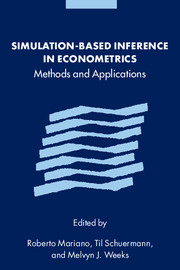Book contents
- Frontmatter
- Contents
- List of contributors
- Foreword by M. Hashem Pesaran
- Part I Simulation-based inference in econometrics: methods and applications
- Part II Microeconometric methods
- Part III Time series methods and models
- Part IV Other areas of application and technical issues
- Introduction
- 12 A comparison of computational methods for hierarchical models in customer survey questionnaire data
- 13 Calibration by simulation for small sample bias correction
- 14 Simulation-based estimation of a non-linear, latent factor aggregate production function
- 15 Testing calibrated general equilibrium models
- 16 Simulation variance reduction for bootstrapping
- Index
14 - Simulation-based estimation of a non-linear, latent factor aggregate production function
Published online by Cambridge University Press: 04 August 2010
- Frontmatter
- Contents
- List of contributors
- Foreword by M. Hashem Pesaran
- Part I Simulation-based inference in econometrics: methods and applications
- Part II Microeconometric methods
- Part III Time series methods and models
- Part IV Other areas of application and technical issues
- Introduction
- 12 A comparison of computational methods for hierarchical models in customer survey questionnaire data
- 13 Calibration by simulation for small sample bias correction
- 14 Simulation-based estimation of a non-linear, latent factor aggregate production function
- 15 Testing calibrated general equilibrium models
- 16 Simulation variance reduction for bootstrapping
- Index
Summary
Introduction
The purpose of this chapter is to explore in detail a number of econometric issues associated with the specification and estimation of a non-linear, latent variable aggregate production function developed in Krusell, Ohanian, Rios-Rull, and Violante (1995) (hereafter KORV). In particular, we discuss how different simulation-based methods can be used to address a number of difficult problems associated with our particular model, and evaluate the relative performance of these methods. Since some of these issues have not been analyzed in much detail using simulation-based methods, the findings reported here may be of use to other researchers working in similar environments.
In our earlier paper, we developed an aggregate production function that differs substantially from the standard production function used in macro-economic analysis. The development of our alternative model was motivated by a key fact of the US economy. In the last 30 years, a substantial difference has emerged in the growth rates of wages for workers with different educational levels. John, Murphy, and Pierce (1993) report that the median wage earner among college graduates experienced a 15 percent increase in inflation-adjusted wages between 1964 and 1988, while the median wage earner among high school graduates experienced a 5 percent decline in real wages over the same period. The widening gap in the relative wage of skilled or unskilled labor is commonly referred to as the “wage premium” or “skill premium.”
Information
- Type
- Chapter
- Information
- Simulation-based Inference in EconometricsMethods and Applications, pp. 359 - 399Publisher: Cambridge University PressPrint publication year: 2000
Accessibility standard: Unknown
Why this information is here
This section outlines the accessibility features of this content - including support for screen readers, full keyboard navigation and high-contrast display options. This may not be relevant for you.Accessibility Information
- 7
- Cited by
